The church of San Pietro in Vincoli (St. Peter in Chains) is named for the chains that held St. Peter when he was imprisoned in Rome and in Jerusalem. The chains are on display in a reliquary at the confessio in front of the high altar.
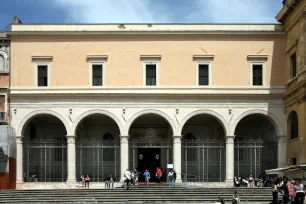
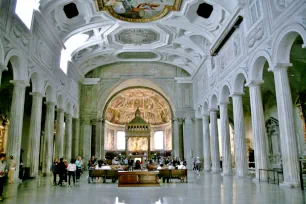
The church is however best known for the statue of Moses that Michelangelo created for the tomb of Pope Julius II.
History
St. Peter in Chains is also known by the name of Basilica Eudoxiana, after Licinia Eudoxia, wife of Emperor Valentinian III (425-455). Eudoxia brought the chains that held St. Peter while he was imprisoned in Jerusalem to Rome. This leads many to believe that the church was founded in the fifth century to house the important relic, but in fact the church is much older and was initially dedicated to both Saint Peter and Saint Paul. The church was damaged in the sixth century during an invasion by the Ostrogoths, and repaired by Pope Pelagius I. It was restored several times more between the eighth and fifteenth centuries and in 1475 the church was even partly reconstructed. Much of the interior, including the painted ceiling, dates from the eighteenth century.
The Chains of St. Peter

In the fifth century, Juvenal, the bishop of Jerusalem, gave the chains that possibly held St. Peter while he was imprisoned in Jerusalem to Eudoxia’s mother, who sent them to her daughter in Rome. Eudoxia then gave the chains as a present to Pope Leo I, who placed them in this church, together with the chains that had held St. Peter while he was in the Mamertine prison in Rome. According to a medieval legend, the two chains then miraculously joined together. The chains are now prominently displayed in a beautiful golden reliquary.
Michelangelo’s Moses statue
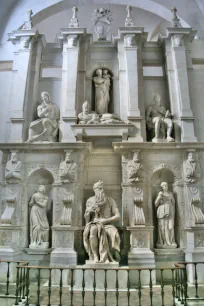
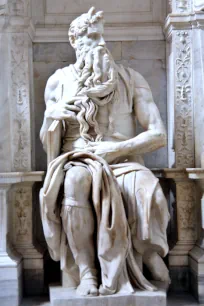
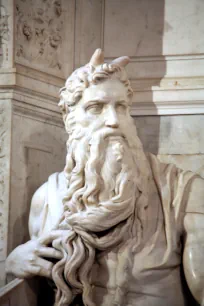
Most people visit the church to see the tomb of Giuliano della Rovere who, in 1503, became Pope Julius II. In 1505 the pope asked Michelangelo to come to Rome to work on his tomb. He intended the monument to be placed right under the dome of the new St. Peter’s Basilica.
Michelangelo designed a huge monument with forty statues. He went to Florence to select the best blocks of Carrara marble and started sculpting. But in 1508, the pope’s attention turned to the decoration of the Sistine Chapel, and he wanted Michelangelo to paint the ceiling of the chapel. Michelangelo begrudgingly obliged – he saw himself more as a sculptor and architect than a painter – and created his famous ceiling painting. Shortly after this work was completed, Julius II died, and his successors commissioned Michelangelo with other tasks. They weren’t very interested in the sepulchral monument of one of their predecessors, so Michelangelo could only work on it sporadically. By the time Michelangelo died in 1564 only the statues of Moses, Leah, Rachel and two dying slaves were completed.
No one knows exactly what the monument was supposed to look like, but it was likely that the statue of Julius would have been the centerpiece of the composition, with Moses and Christ at the top. Instead, it is now the statue of Moses that prominently takes a central position. He is flanked by Leah and Rachel, both created in the latter years of Michelangelo’s life. Two unfinished statues of dying slaves are now in the Louvre in Paris and the Galleria dell’Accademia in Florence. The statues above Moses were created by Michelangelo’s students; the lying figure of Julius II however might also be the master’s own work, experts are still divided.
The statue of Moses grabs the attention of onlookers not only thanks to its prominent position, but also because of its captivating appearance. Even Michelangelo considered the statue one of his best works, and the story goes that he found it so lifelike that he started talking to Moses. When the statue didn’t answer, Michelangelo became angry and in a fury he threw a chisel at the knee of Moses. This would explain the cut you can see on the statue’s right knee. The horns you see on Moses’s head are the result of an incorrect translation of the Old Testament. In the Middle Ages, it was thought that the original scripture said that the head of Moses was horned. Now we know that the text actually says that his face ‘radiated’.

Other sights of interest
The curved ceiling of the church’s central nave was created in 1706. The magnificent ceiling painting, a work of Giovanni Battista Parodi, depicts the Miracle of the Chains. Flanking the nave are two rows of ten massive Doric columns, most likely taken from an ancient Roman bath or temple.
Near the altar on the left side of the church is the tomb of Nicholas of Kues, a German theologian and papal envoy who in 1440, long before Copernicus, realized that the earth was not the center of the cosmos.
- Next: Palazzo Altemps
- More Sights & Attractions in Rome

